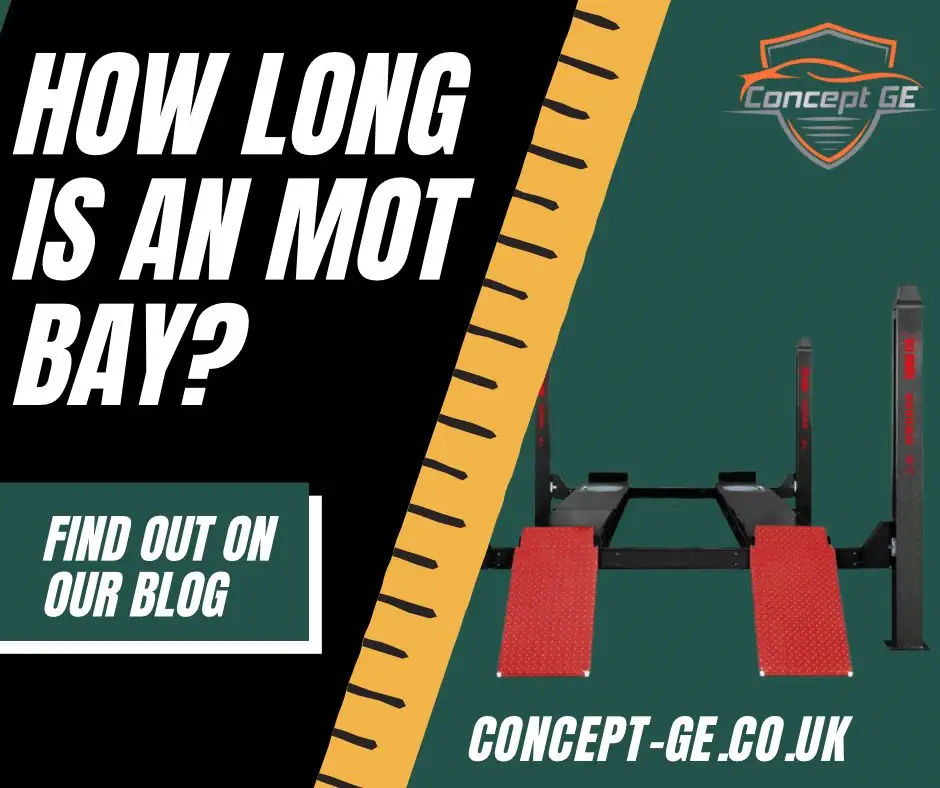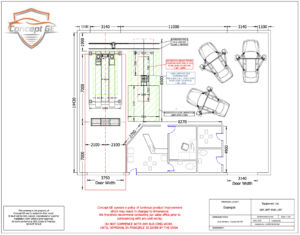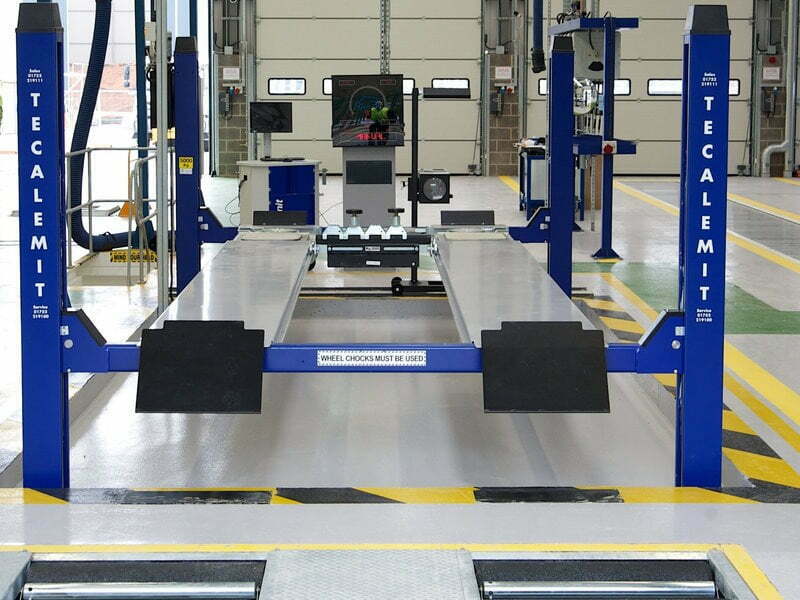MOT Bays can be created in various configurations and lengths. The most fundamental part of planning to open a new MOT station is to ensure the premises are suitable for the class or classes of vehicle you wish to test.
Click here to find out what the different classes of MOT Bay are.
The length of the MOT bay will be dependent on your choice of equipment and the premises. For example, an MOT bay has a standard configuration of the Headlamp Beam Tester, then the MOT Lift / Ramp, and then the Roller Brake Tester (RBT).
Another important factor to consider with your MOT Bay dimensions will be whether your MOT ramp is surface mounted or recessed. Again, this is dependent on the space available within your premises.
MOT Bay Sizes and Dimensions
Below are some important MOT Bay dimensions and size requirements that you need to consider before committing to any premises, these relate to the most common MOT Bay classes and types that we see, but if you have a specific question not covered here please call us on 0113 469 0572 or use the online contact form.
Class 4 MOT Bay dimensions
The length of the Class 4 MOT bay will be impacted based on whether you have an MOT lift or a pit in place.
If there is an inspection pit, then the height and some of the other size requirements also reduce in size.
Class 7 MOT Bay dimensions
As above, Class 7 MOT bay dimensions will be impacted based on whether you have an MOT lift or a pit in place.
Again if an inspection pit is used rather than a lift then some of the Class 7 MOT Bay size requirements reduce to account for this.
Class 4 MOT Bay dimensions with MOT Ramp size requirements
Height requirement – This can be confusing at times so the easiest way to explain this is if you were to imagine a glass box around your MOT ramp.
The glass box must be extended 500mm from the outer edges of each platform left and right, 500mm to the rear of the ramp and 1000mm out from the drive on the end of the ramp. This glass box must be 3800mm high.
If that glass box fits where the ramp is to be installed, then the height is not a problem. If anything enters the glass box, this is a problem and it may cause DVSA (Driver and Vehicle Standards Agency) to reject your application. There may be a solution should you face this problem by using a slightly different configuration on the layout of the MOT bay, but this is dependent on the space available within your premises.
Some more essential MOT Bay dimensions to know
- The overall width of a class 4 MOT bay is 3600mm
- Vehicle entrances and exits must be a minimum of 2400mm in height and wide
- Headroom over lift 3800mm as explained above
- Headroom over brake test standing area 2400mm
- Brake test standing area width 2400mm
- Brake test standing area length 9000mm – This can be part of your ramp if the ramp is recessed into the floor and level with your roller brake tester
Class 4 MOT Bay dimensions with an Inspection Pit size requirements
Height requirement – When using an inspection pit instead of a ramp then the height considerably reduces from 3800mm to 2400mm.
The use of a pit may be the only option available to you if you don’t have the required height or width within your premises.
Again, using the glass box to help, you will need to imagine your glass box 3600mm in width and 2400mm high the whole length of your MOT bay. If that glass box fits, then there is no issue.
Inspection Pit size requirements
- A working length of at least 3900mm
- A width of at least 760mm and not more than 920mm over the working length measured across both pit walls
- A depth of at least 1500mm and not more than 1800mm, over the working length
- Adequate access for personnel to enter the pit which does not intrude on the working dimensions
Some more essential dimensions to know about using an MOT inspection pit
- The overall width of a class 4 MOT bay is 3600mm
- Entrances and exits must be a minimum of 2400mm in height and width
- Headroom over brake test standing area 2400mm
- Brake test standing area width 2400mm
- Brake test standing area length 9000mm – Part of this can be either side of your pit
Class 7 MOT Bay dimensions with MOT Ramp size requirements
Height requirement – Use the same example of a class 4 MOT bay if you imagine a glass box around your MOT ramp.
The glass box must be extended 500mm from the outer edges of each platform left and right, 500mm to the rear of the ramp and 1000mm out from the drive on the end of the ramp. This glass box must be 4800mm high.
If that glass box fits where the ramp is to be installed, then the height is not a problem. If anything enters the glass box, this is a problem and may cause DVSA (Driver and Vehicle Standards Agency) to reject your application. There may be a solution should you face this problem by using a slightly different configuration on the layout of the MOT bay, but this is dependent on the space available within your premises.
Some more essential dimensions to know
- The overall width of a class 7 MOT bay is 4200mm
- Vehicle entrances and exits must be at least 3200mm high by 3000mm wide. If part of the brake test standing area is outside of the door, then it must be at least 3500mm wide
- Headroom over brake test standing area 3200mm
- Brake test standing area width 4200mm
- Brake test standing area length of 14000mm – This can be part of your ramp if the ramp is recessed into the floor and level with your roller brake tester
Class 7 MOT Bay dimensions with an Inspection Pit size requirements
Height requirement – When using a Pit instead of a ramp the height considerably reduces from 4800mm to 3200mm.
The use of a pit may be the only option available to you if you don’t have the required height or width within your premises.
Again, using the glass box to help, you will need to imagine your glass box 4200mm in width and 3200mm high the whole length of your MOT bay. If that glass box fits, then there is no issue.
MOT Inspection Pit size requirements
- A working length of at least 6000mm
- Minimum width of 760mm and not more than 1300mm over the working length measured across both pit walls
- A depth of at least 1400mm and not more than 1800mm, over the working length
- adequate access for personnel to enter the pit which does not intrude on the working dimensions
- sealed to prevent the ingress of water
Some more essential dimensions to know about using a pit
- The overall width of a class 7 MOT bay is 4200mm
- Headroom over brake test standing area 3200mm
- Brake test standing area width 3500mm
- Brake test standing area length of 14000mm – Part of this can be on either side of your pit
When thinking about the layout of your new MOT bay whatever class of vehicle you wish to test, it’s always good practice to think about what you wish to do with the rest of the space you have available. For example, do you want to install a tyre-changing machine and wheel balancer, wheel alignment machine or other garage ramps or vehicle lifts?
Depending on your plans this could alter the way the MOT bay is configured. The MOT bay can be inline or side by side it may also include the option to carry out wheel alignment on your MOT equipment.
It’s always recommended to have your chosen equipment supplier conduct a site survey and discuss all your options available to you. This should then be backed up with a CAD design layout drawing. The drawing is a requirement of DVSA as part of your VT01 application also.
Need help with the design of your MOT Bay?
How long is your MOT Bay? And do you need help with the design, supply and installation of a new MOT Bay?
Concept Garage Equipment engineers are experts in MOT Bay layout design and construction and can advise on, supply, install and train you on all garage and MOT Bay equipment anywhere in the UK, we can also supply MOT Bay Packages to suit your individual garage needs.
Call us today on 0113 469 0572 or use the online contact form, and we will help you create the MOT Bay of your dreams.
MOT Bay Frequently Asked Questions
What is an MOT Bay?
An MOT Bay is a place where vehicles can be tested for their MOT requirements. The garage will usually have a vehicle lift or inspection pit where vehicles can be fully inspected and have their MOT requirements checked to ensure they comply.
Some of the MOT tests for vehicles in the UK include testing the wheels, brakes, vehicle emissions and headlight adjustments for example.
MOT garages are a great place to have your vehicle checked and repaired if it needs it. They are also a good place to get information about the MOT regulations and keep up to date with current MOT laws also.
However not all garages are qualified to perform MOT tests and as a vehicle user, it is important to check that the garage you choose has all of the required equipment and training to do the MOT test correctly.
Any garage who have the experience, training and equipment to perform vehicle MOT inspections, naturally gets more work, as cars, motorcycles and other vehicles are being checked more frequently on their premises.
MOT bays were originally designed to provide motor vehicle testing and repair services. They are now used primarily as car repair shops, and often advertise their services as MOT bays. Most of the largest MOT bays in the UK are franchised dealerships, although some independent garages and small chains also offer MOT testing. The majority of smaller MOT bays can be found in local independent garages.
Over the years, MOT bays have evolved into a one-stop shop for all your vehicle needs. Whether you need a full service, a diagnostic, or a simple tyre rotation, you can pop into an MOT bay and get everything you need under one roof. No need to call out different specialists for different jobs, just head to an MOT bay and get all the vehicle services you need in one place.
MOT bays, also known as MOT testing stations or car servicing stations, are the locations where vehicles are inspected for roadworthiness—also known as an MOT test.
What is an ATL MOT Bay?
The Automated Test Lane, or ATL, is an automated testing facility.
An ATL bay can perform multiple vehicle tests, such as a full vehicle inspection, a vehicle diagnostic and a vehicle service and is a great option for large vehicle services, such as oil changes, where it makes sense to have multiple services performed on a single vehicle.
An ATL bay can save time and money compared to having multiple services performed on multiple vehicles.
How long is an MOT Bay?
The length of the MOT bay will be dependent on the class of vehicles you intend to work on, the choice of garage equipment and both the layout and size of your premises.
Click here to find out what the different classes of MOT Bay are.
- The overall width of a class 4 MOT bay with an inspection pit or ramp is 3600mm
- The overall width of a class 7 MOT bay with an inspection pit or ramp is 4200mm
Another important factor to consider with your MOT Bay dimensions will be whether your MOT ramp is surface mounted or recessed. Again, this is dependent on the space available within your premises.
For a full detailed answer and specific dimensions for the different classes of MOT Bays, please see our article on this subject:
What is needed to be an MOT test centre?
First, you will need to make sure that you have the correct training and qualifications to become an MOT tester in the first instance. Without the correct qualifications, you will not be approved by the Drivers and Vehicle Standards Agency (DVSA). You will also need to decide who should become the AEDM (Authorised Examiner Designated Manager).
If you have one site, then this would need to be a director or sole trader of the business. This person would also need additional training to carry out the role of AEDM.
You will also require premises that comply with the Drivers and Vehicle Standards Agency (DVSA) regulations. For example, you will need the height, length and width required for the classes of vehicles you would be testing. Also that the door and any openings to the MOT bay in and out meet the minimum width and height required.
There is a lot to think about before taking on any commitment with premises. You are strongly advised to have these important dimensions checked by a qualified competent person before deciding on any premises.
Once you have decided on the training and the premises meet the required dimensions you will need to think about the range of equipment you would like to become an approved MOT test Centre. The range of equipment can be…
- Vehicle lift/ramp/pit
- Headlamp Beam Tester
- Roller Brake Tester
- Emissions Tester
- Decelerometer
- Various hand-held tools
- Tool board and signage
This is not a list of every possible piece of MOT Bay Equipment you may need, as every MOT Bay is different, but please call us today to discuss how we can help you set up or upgrade your MOT Bay on 0113 469 0572.
What are the correct MOT Bay Layout and Dimensions?
MOT Bays can be created in various lengths and dimensions depending on the configuration.
The most fundamental part of planning to open a new MOT station is to ensure the premises are suitable for the class or classes of vehicle you wish to test.
MOT Bays come in various classes - Class 1,2,4 & 7 are the DVSA Approved MOT Testing classes
Click here to find out what the different classes of MOT Bay are.
The length of the MOT bay will also be dependent on your choice of equipment and the premises. For example, an MOT bay has a standard configuration of the Headlamp Beam Tester, then the MOT Lift / Ramp, and then the Roller Brake Tester (RBT).
Another important factor to consider will be is whether your MOT ramp is surface mounted or recessed. Again, this is dependent on the space available within your premises.
What is MOT connected equipment?
From 1st October 2019, The Driver and Vehicle Standards Agency (DVSA), in association with the Garage Equipment Association (GEA) announced they would be enforcing the use of Connected Equipment for MOT testing across the UK, meaning that all new or replacement MOT testing equipment must be able to connect to this new electronic recording service.
However, due to the number of garages, manufacturers and pieces of equipment involved, the rollout of this new legislation was to be phased in over several years, from the proof of concept in Q3 2018, the first piece of equipment this applies to in a live environment was roller brake testers (RBTs). The rule applied to all new or replaced RBTs from 1 October 2019.
Is an MOT viewing area a legal requirement?
Yes, an MOT viewing area is a legal requirement, as any person presenting a vehicle for an MOT test has the right to observe the test in safety from an approved viewing area.
The DVSA states that the premises must have:
- a clearly defined weatherproof viewing area from which all stages of the MOT test in progress can be observed safely without interruption, except for road testing (room for 2 seated people is considered sufficient)
- a sign installed in the customer reception area to alert presenters of vehicles for MOT tests of the presence of the MOT viewing area
- safe access from the customer reception to the designated viewing area if the viewing area is to be located in the workshop
As an alternative, you can install a fixed display monitor in the customer reception or waiting area to display a ‘live feed’ of the whole of the MOT bay testing area. The image displayed on the monitor must be in colour and of good quality but must not be recorded.




